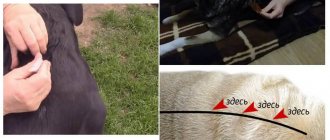Flea allergies in dogs occur in response to parasite bites, because their saliva contains substances that cause hypersensitivity reactions. If left untreated, severe complications occur in the form of anaphylactic shock, respiratory and heart failure, including death.
Allergy to fleas in a dog.
Symptoms and behavior of animals
Manifestations of flea allergy can be noticed by the rapidly changing behavior and condition of the pet. Symptoms of flea dermatitis in dogs:
- Severe itching. The dog itches continuously, which leads to redness of the skin and the appearance of abrasions and open wounds on it.
- Dandruff. Small white flakes can be seen on the fur.
- Unpleasant odor emanating from the body and mouth.
- Lack of appetite.
- Digestive system disorders: frequent constipation or prolonged diarrhea, nausea and vomiting.
- Formation of edema on the mucous membranes.
- Dryness and flaking of the skin.
The pet's behavior changes radically: it becomes lethargic, refuses to go out, ears droop, and constantly wags its head.
Self-diagnosis
The owner can determine the presence of an allergic reaction to parasites in a dog independently through a thorough examination. Fleas choose to settle on the rump, stomach, root of the tail and inner thighs. When an allergy develops, the animal begins to intensively scratch these areas. Having parted the fur, the owner will find a large number of fleas and nits. The latter are not difficult to identify: they look like a small black dot and can be easily removed from the animal’s fur with your fingers. Female fleas, engorged with blood, are brown in color and have a large body.
Examination of the dog.
The combination of a large number of parasites, constant itching in the animal and the presence of inflammatory foci with purulent contents on the body indicate that the dog is allergic to flea bites.
There are situations when a dog has only a few parasites on its body; the rest hide in carpets and upholstered furniture, periodically attacking the animal. Even if the owner has no doubt that the pet is allergic to flea bites, before starting treatment, it is necessary to show the animal to a veterinarian to clarify the diagnosis.
Danger and possible consequences
Allergies in dogs require immediate treatment, since the disease can cause a number of complications and serious consequences. Intensive scratching of the skin leads to the appearance of open wounds, in which a favorable environment is created for the development of pathogenic microflora that comes from the outside or is brought in by the parasites themselves. This leads to the appearance of purulent-inflammatory processes that provoke severe intoxication of the animal.
Late treatment of allergies can lead to dermatitis becoming chronic with frequent outbreaks of relapses. A weakened animal’s body and a depressed immune system can lead to consequences such as heart or respiratory failure. Untreated parasite allergies often lead to the death of dogs.
Formation of wounds due to flea bites.
Causes of allergies in dogs
The body of living beings, when exposed to an allergen, creates an immune response that protects it from the negative effects of pathogenic substances. Not everyone will have the same reaction. If an animal shows symptoms, it means it is oversensitive. Usually the pathology is observed in individuals older than two years, but sometimes allergies occur in a puppy. All dogs are susceptible to it - small breeds (pug), medium-sized (Staff, Jack Russell), large (husky).
The exact reason for its formation has not been established. Possible factors are considered:
- Genetic predisposition. Typically, the pathology occurs in bulldogs, dachshunds, Labradors, and Shar-Peis.
- Non-standard structure of the endocrine and nervous system organs in a number of breeds.
- Prolonged stay in a state of stress.
- Lack of treatment for worms.
- Chronic or acute infectious pathologies.
When an allergen appears in the body, the immune system produces specific antibodies. Their reaction is exclusively to antigens of a certain type.
If antigens penetrate regularly, antibodies form immune complexes. They remain in cells where there are substances responsible for inflammation in allergies - histamine, etc.
Mediators cause the release of components into the bloodstream, which carries them throughout the body. The inflammatory process begins where they end up. Such manifestations as swelling, rashes on the skin, redness, and intestinal spasms are noticed. They often disrupt the functioning of the circulatory system.
Certain allergens are capable of changing their structure. The immune system considers them abnormal components. For this reason, lymphocytes and white blood cells begin to be produced. This process is observed with the development of skin pathology – psoriasis. There are several types of allergies in dogs, each with its own nuances.
Features of the course of allergies
The reaction to flea saliva in dogs is related to the season of the year. Most often, an allergy outbreak occurs in spring and summer. Signs may appear immediately after the bite or be sluggish, it all depends on the degree of sensitivity of the body. But in most cases, reactions occur due to numerous bites and prolonged presence of parasites on the animal’s body.
The first sign is itching, which can last from several hours to 2 days. Other symptoms:
- deterioration of skin condition;
- changes in general condition and behavior: appear after several weeks or months, depending on how sensitive the animal’s skin is.
In order to detect the disease in time and prevent the condition from worsening, you need to immediately respond to the appearance of prolonged itching in your pet. Timely examination and provision of veterinary care will help save the dog not only health, but also life.
Allergy symptoms
When the body produces antibodies, the flea bite area begins to itch very much. Pets infected with fleas find themselves in a similar situation. Cats and dogs often develop minor irritation to the point of blood and bald spots appearing at the site of small insect attacks.
External symptoms:
- Redness of the bite site.
- The appearance of a small black dot.
- With a large number of bites on the affected area, itchy hives begin.
- Many papules appear. They are light in color in the center with pronounced redness at the edges.
A flea allergy in children with severe damage or active production of antibodies can lead to serious consequences. Each case of a nonspecific reaction requires contacting a therapist, dermatologist and allergist. Bruises may appear at the sites of flea bites.
Actions for anaphylactic shock
A large accumulation of parasites on the body and numerous bites can provoke anaphylactic shock, leading to the death of the animal without proper assistance. In this condition, the dog must be urgently taken to a veterinary clinic. If you can’t do this quickly, you can save your pet’s life by providing the correct first aid:
- If the dog is conscious and able to swallow, it should be given an antihistamine. The medicine will help reduce the intensity of symptoms.
- Breathing is accompanied by gurgling sounds - a sign that the lungs are filling with fluid. If the animal is conscious, it must be taken by the hind legs and lifted, holding in this position for 10 seconds.
- The dog is not breathing - artificial respiration is required. The pet should close its mouth and inhale air quickly and rhythmically 2 times into its nose. In 1 minute you need to take 15 to 20 breaths into the nose until the animal begins to breathe on its own.
Anaphylactic shock in a dog.
After all the manipulations have been completed, take the pet to the hospital. At the veterinary clinic, the animal is administered anti-shock and potent antihistamines, and symptomatic therapy is provided if necessary.
Allergy treatment
Treatment methods are selected depending on the severity of the symptomatic picture. But the first thing the owner needs to do is rid the animal of parasites using special shampoos and drops. In addition to cleaning the dog's skin and fur from fleas, it is recommended to disinfect all furniture in the house, carpets and bedding that may contain them.
A diet is required. When feeding a dog with ready-made commercial diets, it must be switched to hypoallergenic food. If the pet is on a natural diet, the veterinarian selects the menu for her.
Drug therapy
When treating flea dermatitis, antihistamines are necessarily prescribed to inhibit the effect of the hormone histamine and relieve the signs of pathology. The following drugs are used in therapy:
- Diphenhydramine. The drug eliminates inflammation and relieves allergic reactions.
- Cyprodine. This is an oral medicine. Cyprodine eliminates fever and relieves severe itching.
- Diprazine. Release form: tablets and solution for intramuscular administration.
- Astemizole. The medicine should not be given to pregnant dogs.
If the allergy is advanced and antihistamines do not give a positive result, the animal is prescribed glucocorticosteroids. To restore the body depleted by allergies, vitamin complexes, immunomodulators and supporting drugs that contain iron are used.
Therapeutic injection for a dog.
Folk methods of struggle
Along with taking medications, traditional methods of therapy can be used in the treatment of flea dermatitis. To speed up the healing process of the skin and relieve itching, it is recommended to treat the affected areas of the skin with decoctions based on medicinal herbs: chamomile, calendula, coltsfoot, comfrey and sage.
All decoctions are prepared according to the same recipe:
- 1 tbsp. l. the selected herb is poured with a glass of boiling water.
- The liquid is infused until it cools completely, after which it is filtered.
- A cotton pad is moistened with the decoction. They treat the skin carefully, without pressing too hard.
Aloe heals skin well. It is recommended to grind the cut leaf of the plant into a paste and apply it to the skin for 30 minutes. Since aloe has a pronounced laxative effect, it can be used in areas where the dog cannot reach with its tongue.
Aloe juice purchased at a pharmacy can be added a few drops to your pet’s food. This will help improve digestion and strengthen the immune system so that the body can independently resist allergens, thereby reducing the intensity of symptoms of the disease.
Echinacea is another effective remedy for treating flea dermatitis in dogs. Gauze, folded several times, should be moistened in it and applied to the damaged area. Keep the compress for up to 30 minutes.
It is important to remember that traditional methods cannot be used as the only method of treating flea allergies in dogs. Such treatment is only an addition to the main drug therapy.
How does an allergy manifest itself?
If you notice itching, painful skin rashes and irritation, you must first make sure that the allergy diagnosis is correct. Representatives of the Chinese Crested breed often exhibit sun intolerance. This fact was confirmed by experts quite a long time ago.
Yorkshire Terriers often do not accept protein foods. Sometimes small traces of parasite bites are mistaken for allergies. When trying to find the cause of the pathology, one should take into account the nuances of the breed and symptoms that are characteristic of a particular disease.
The main manifestations of allergies in dogs:
- Redness on the skin, hyperemia.
- Rashes.
- Local hair loss.
- Swelling of the paws.
- Bronchial spasm.
- Problems in the digestive system.
- Itching.
- Peeling.
- Tearing.










